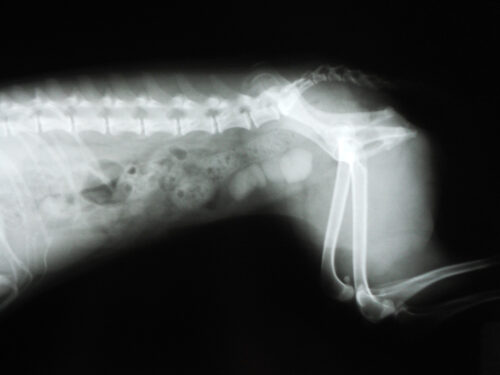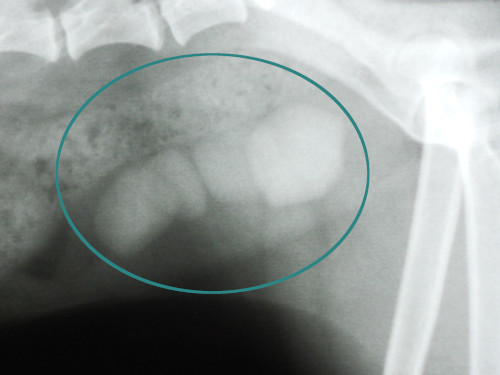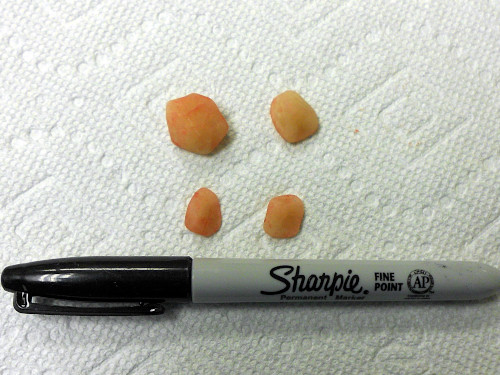 A 9-year-old Shih-Tzu mix was showing an increased urge to urinate but was straining to do so once outside. After viewing a urine sample under the microscope Dr. Neumeister found a large amount of white blood cells (WBC), red blood cells (RBC) and transitional cells. A radiograph of the abdomen showed 4 uroliths (bladder stones) with diameters between 1/2 to 1 cm. Dr. Neumeister decided a cystotomy (surgical opening created in the wall of the urinary bladder) to remove the uroliths was needed.
A 9-year-old Shih-Tzu mix was showing an increased urge to urinate but was straining to do so once outside. After viewing a urine sample under the microscope Dr. Neumeister found a large amount of white blood cells (WBC), red blood cells (RBC) and transitional cells. A radiograph of the abdomen showed 4 uroliths (bladder stones) with diameters between 1/2 to 1 cm. Dr. Neumeister decided a cystotomy (surgical opening created in the wall of the urinary bladder) to remove the uroliths was needed.
 This procedure is done under general anesthesia to induce unconsciousness, pain control, and muscle relaxation. We induced anesthesia by giving an intravenous injection of Propofol. It will take between 75 and 120 seconds to reach unconsciousness and muscle relaxation. Once the jaw had gone slack an endotracheal tube was placed in the trachea (windpipe) and then attached to the anesthesia machine. Now the patient was breathing in the gas anesthetic and oxygen through the tube.
This procedure is done under general anesthesia to induce unconsciousness, pain control, and muscle relaxation. We induced anesthesia by giving an intravenous injection of Propofol. It will take between 75 and 120 seconds to reach unconsciousness and muscle relaxation. Once the jaw had gone slack an endotracheal tube was placed in the trachea (windpipe) and then attached to the anesthesia machine. Now the patient was breathing in the gas anesthetic and oxygen through the tube.
During surgery the heart rate and respiratory rate were monitored manually by a technician.
 In addition the patient’s heart rate, respiratory rate, oxygen saturation, body temperature, electrocardiogram (ECG), PCO2 and blood pressure are always monitored electronically to determine the depth of anesthesia during surgeries. Intra-operative medication was given intravenously to prevent post-operative discomfort. Some blood-tinged urine is expected for the first few days. The uroliths were sent to a laboratory for mineral analysis to gain insight as to why developed and how to prevent them in future.
In addition the patient’s heart rate, respiratory rate, oxygen saturation, body temperature, electrocardiogram (ECG), PCO2 and blood pressure are always monitored electronically to determine the depth of anesthesia during surgeries. Intra-operative medication was given intravenously to prevent post-operative discomfort. Some blood-tinged urine is expected for the first few days. The uroliths were sent to a laboratory for mineral analysis to gain insight as to why developed and how to prevent them in future.
